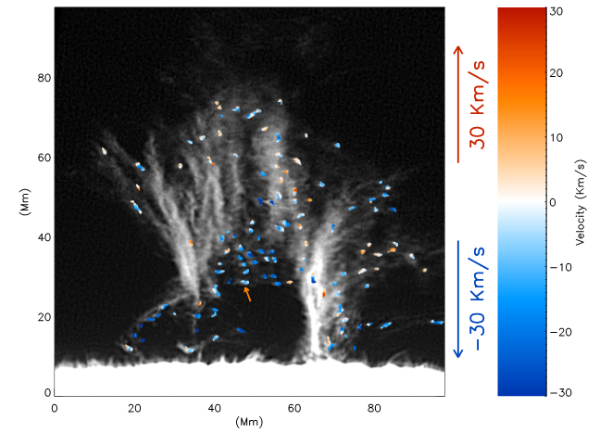Coronal heating is a topic dedicated to explaining how the corona may be heated up to a temperature of millions of degrees, far above that of the photosphere. Alfvén-wave turbulence is a promising candidate to transport magnetic energy into the corona, but how the wave is generated in the corona is still an open question.
Dr. BI Yi and his cooperators, from Yunnan observatories of Chinese Academy of Sciences, noted that Alfvénic wave energy communicated by the descending knots in the solar prominence may well contribute in a nonnegligible way to the local heating of the surrounding corona.
This investigation is based on the observation from NVST, which is a ground-based multichannel high-resolution imaging system, including Hα, G-band, TiO-band, and CaII wavelengths. The NVST Hα datas are useful to study the dynamics of quiescent prominences. The investigated prominence is shown in the Figure, in which the descending and rising knots in the prominence investigated are colored.
In this work, researchers tried to estimate the loss rate of the gravitational potential from the descending knots and compared it with heating power requirement for the corona in the quiet Sun. After investigating the size, velocity and path of thousands of the falling knots in this prominence, they noted that the gravitational energy loss rate of these observed knots amounts to about 1/2000 of that required to heat the entire quiet Sun, increasing to 1/320 when considering possibly further downward motions of the knots having disappeared in the Hα observations.
Assuming that the descending knots were capable of exciting Alfvén waves that could then dissipate within the local corona, the gravitational potential energy of the knots may have been converted into thermal energy. Such a mechanism may contribute to the heating of the corona local to these prominences.
Recently, this work was published online in The Astrophysical Journal Letters.
A robust estimation of the density of the knots in the prominence will allow us to precisely estimate the loss rate of the gravitational potential of the falling plasma. Additional modeling work is also required in order to reveal how the interaction between the falling dense plasma and the magnetic field generates the Alfvén wave, dissipation of which is capable of contributing to the heating of the local corona.
Contact:
BI Yi, Yunnan Observatories, CAS
biyi@ynao.ac.cn

The background is NVST Hα image on 2017 January 7. The identified knots are colored based on the value of vertical Demon velocity.(Image by BI Yi)